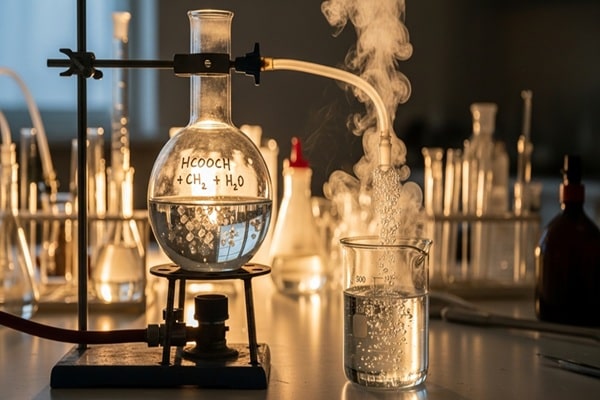Ever wonder how everyday products like paint or nail polish remover work? The answer often lies in a small yet powerful molecule called methyl acetate—chemically written as hcooch ch2 h2o. This compound is a silent superstar in chemistry, helping us understand reactions and find practical uses in daily life.
Whether you’re a student studying organic chemistry or just someone curious about what goes into your cleaning products, this guide will walk you through everything from how methyl acetate reacts to how you can safely handle it. Picture a friendly chat with a science-savvy friend—that’s what you’re about to get.
1. What Is Methyl Acetate, Anyway?
Let’s start with the basics. Methyl acetate is a simple ester, made when methanol (a simple alcohol) reacts with acetic acid (the type found in vinegar). That’s why its shorthand looks like chips of Python code—“hcooch ch2 h2o”.
Chemically, it has a low boiling point and evaporates quickly. That volatility is exactly why it’s so handy in products that dry fast—like paints and coatings.
This compound isn’t just a one-trick pony. It’s used in more than just industry labs. In fact, you might bump into it in everyday items—making it a versatile piece of everyday chemistry.
2. Why Methyl Acetate’s Reactions Matter
When we talk about chemical reactions, temperature, concentration, and catalysts matter. With methyl acetate:
-
Higher temperatures speed things up—molecules move faster, collisions increase, and reactions go quicker.
-
Concentration plays a part, too. If there’s more methanol or acetic acid, you’ll get faster ester formation.
-
Catalysts (like acids or bases) make the reaction more efficient, turning those raw ingredients into methyl acetate without being consumed.
-
pH levels also influence things—acid or base can push the reaction forward or reverse it.
Together, these pieces form a beautiful puzzle. By understanding them, chemists can control how much ester they get, how pure it is, and how fast it forms.
3. Everyday Uses You’ll Recognize
Fast-Drying Solvent
Methyl acetate is a go-to in paints, varnishes, and glues. It dissolves various compounds and doesn’t stick around long—it evaporates quickly, leaving a clean finish.
Nail Polish Removers
The same evaporation trait makes it a popular nail polish solvent. It breaks down old lacquer fast and obliterates strong odors quickly.
Flavor and Fragrance Booster
In foods and drinks, this compound provides light, fruity hints—especially in candy, soda, or baking flavors. Definitely artificial, but safe in regulated amounts.
Degreaser and Cleaner
Methyl acetate shines in cleaning. It removes grease, wax residues, and other bad actors from surfaces—swiftly and effectively.
Intermediate in Synthesis
Chemists also use it as a building block in the lab—something to react into bigger, more complex compounds.
4. What Affects Its Reactions?
Let’s dig into the factors that influence how methyl acetate behaves:
Temperature
Higher temps = faster reactions (until you hit degradation zones).
Concentration
More acid + more alcohol = better yield… generally.
Catalysts
Acidic catalysts speed formation, while acidic or basic conditions aid breakdown.
pH
Embedding ester bonds in acid or base can also reverse the reaction (called hydrolysis).
Pressure
Less critical in everyday settings, but relevant for industrial-scale reactions.
Also Read : A Journey Through Time: The Historical Evolution of Sztavrosz
5. Safety First—Handling Guidelines
Though useful, methyl acetate isn’t totally harmless. Here’s how to work with it responsibly:
-
Personal Protective Equipment (PPE): Wear goggles, gloves, and a lab coat.
-
Ventilation: Always use it in a fume hood or well-ventilated area—those vapors can be irritating.
-
Spill Management: Keep absorbent materials (like kitty litter or special pads) handy. Clean spills promptly and dispose of them properly.
-
Proper Storage: Store it in a cool, dry place—away from strong oxidizers and heat sources.
-
Know Your Emergency Plan: Understand your lab’s or facility’s protocol in case of leaks or exposure.
-
Label MUST: Never store it in an unlabeled container. Keep the label visible and up to date.
-
No Eating or Drinking Nearby: It’s not edible, so keep food and drinks locked away in lab zones.
6. Cracking the Chemistry Code: Why You Should Care
Understanding methyl acetate does more than help in knowing what’s in a bottle. It offers a clear window into how esters play a major role in chemistry—especially when it comes to reaction mechanisms and equilibrium concepts.
By studying it, you’re learning how molecules interact, how to predict product yields, and how to control reactions with variables like catalysts or temperature. That’s not just academic—it’s real-world science that influences everything from manufacturing smells to your morning nail polish routine.
7. Beyond the Lab: Real-World Takeaways
Learning about methyl acetate is like finding a key to various doors:
-
Industrial Applications: It shows how small molecules power big processes.
-
Ambient Tools: It explains why some cleaners evaporate fast and clean thoroughly.
-
Safety Culture: It demonstrates safe chemical use and why labs are built the way they are.
-
Educational Clarity: It’s the ideal example in classrooms to teach ester formation and reactivity.
Wrapping It Up: Methyl Acetate in the Big Picture
Methyl acetate (hcooch ch2 h2o) might seem like a small or dry chemical term, but it plays a major role in everyday products, industry, and chemistry learning. By diving into how it’s made, what affects it, where it shows up, and how to handle it safely, you gain a deeper appreciation of how chemistry touches everything—from the materials we use to the clear skies in our lungs after a cleanup.
So, next time you smell a quick-drying glue, swipe some cleaner for a stubborn stain, or notice a fruity flavor in your beverage, remember there’s likely a little methyl acetate working hard behind the scenes—simplifying your life, scientifically speaking.












Leave a Reply